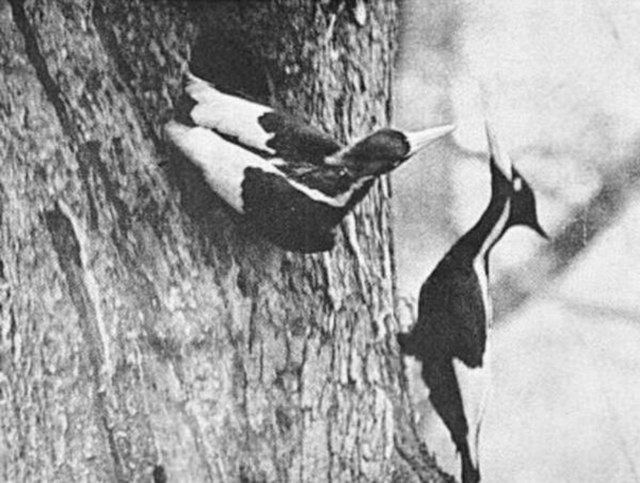New paper claims Ivory-billed Woodpecker survives in Louisiana
A preprint paper has raised eyebrows in the academic world by presenting what it calls "multiple lines of evidence" to support the continued existence of Ivory-billed Woodpecker in Louisiana.
The documentation comes just months after the official declaration of Ivory-billed Woodpecker as extinct by the US Fish and Wildlife Service.
The preprint by researcher Steven Latta and his colleagues can be viewed online, where their photographic evidence is presented. Much of this was obtained via the use of camera traps and drones; so far, no photos of Ivory-billed Woodpecker have been taken by observers using a conventional DSLR setup commonly carried by birders worldwide, despite the thousands of hours invested in searching for the species over the past two decades.

Trail camera photos taken within 50 m of each other on 30 November 2019 (top), and 1 October 2021 (bottom), presented as apparent Ivory-billed Woodpeckers in Latta et al.
Reaction among the scientific community has been mixed. Many consider Ivory-billed Woodpecker to be long lost from the US and regard the latest batch of evidence as further distraction from the reality of the situation, with the woodpeckers depicted in the series of grainy and pixellated videograbs deemed unidentifiable at best, for the common and widespread Pileated Woodpecker cannot be ruled out in any of the presented evidence. Others, however, consider the images to be slightly more compelling.
Unfortunately, the authors indicate that their audio and sighting data is inadmissable as evidence. "Skilled, reliable observers" are stated to have enjoyed "more than a dozen high-quality observations of Ivory-billed Woodpeckers", but that these sightings are not detailed in the paper due to a lack of photographic evidence. Using 90 automated recording devices, the researchers say that "audio data were collected", but that this is "unlikely to be generally persuasive" as to the continued existence of the species.
One of the takeaway points from the paper is the notion that Ivory-billed Woodpecker is an extremely shy and elusive bird, with high mobility across its range, and it is for these reasons that obtaining clear evidence of its continued survival is so challenging. However, some of the last properly documented Ivory-billed Woodpeckers, in Louisiana's Singer Tract in the 1930s, were well photographed – even at this time, nearly a century ago, when camera gear was much more primitive.

A pair of Ivory-billed Woodpeckers at the nest in Singer Tract, Louisiana, in April 1935 (Arthur A Allen / commons.wikimedia.org).
Ivory-billed Woodpecker was one of the largest members of its family in the world and was once fairly widely distributed across southern US states, albeit restricted to mature lowland forests with an abundance of large and old trees. Deforestation was a major contributing factor in the species' demise, as was hunting, and its declining populations only enhanced its popularity with collectors, leading to further declines.
The last universally accepted sighting of Ivory-billed Woodpecker occurred in Louisiana's forests in 1944, with only a string of unverified claims since then. The species was once also found in Cuba, with the last accepted sighting there coming in 1987. Generally, researchers are more optimistic that the species may continue to thrive in remote Hispaniolan forests than in southern US states, although many accept that it is now extinct across the entirety of its historical range.
A quick review of the evidence in the Latta et al. pre-print: “Multiple lines of evidence indicate survival of the Ivory-billed Woodpecker in Louisiana” https://t.co/7rbNX1ZGEg 1/ pic.twitter.com/iEZA7BpUzW
— Alex Lees (@Alexander_Lees) April 14, 2022

